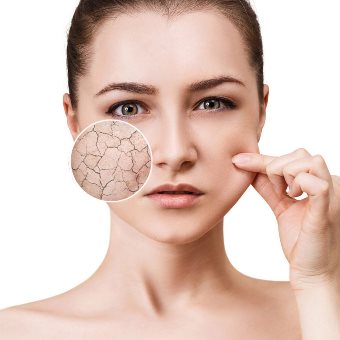Dry or Dehydrated skin – What can you do about it?
Firstly you need to understand the difference between the two and figure out your own skin.

There is a skin type and a skin condition. Your skin type is what you are naturally born with such as oily or dry skin. A skin condition is something that can happen to anyone and can be temporary or longer.
If you have a dry skin type, it means you are lacking in oil naturally, your skin will be dry on your face, body, scalp legs etc. When you moisturise which you will do a lot you will notice it soaks in really quickly. Dry skin lacks oil because it produces less sebum than a normal skin, this lack of sebum means the skin can’t retain moisture but importantly is also means your skin doesn’t get to build up a strong barrier to protect itself against the enviroment.
Dry skin is harder to address as it means a commitment to dry body brushing, exfoliation, changes to diet and lifestyle and often supplementation including essential fatty acids – Omega 3. Often linked with oither skin conditions such as:- eczema, psoriasis and dermatitis best to see your GP or dermatologist for a diagnosis.
A dehydrated skin condition means your body is lacking in water. Caused by lots of different factors, incorrect use of cleanser, weather, caffiene intake, stress, lifestyle this list is long. But here is were it gets tricky: when a skin is dehydrated it creates more oil to make up for the lack of water. This then causes breakout, spots and milia, irritation and dry patches. Skin can feel oily and dry at the same time. However the good news is a dehydrated skin can be dealt with fairly easy.
Did you know that the skin is the largest organ in the body but is the last to get nutrients and water. This is because the body feeds the main organs that keep us alive and the skin, hair and nails gets what is left.
Dry skin test – gently roll over a patch of skin if it flakes and rolls of then it is dry, it can also be red, itchy and irritated.
Dehydrated skin test – pinch the skin on the back of your hand if it stays pinched then it is dehydrated.
SO WHAT CAN WE DO ABOUT IT?
- EXFOLIATE, as dead skin builds up it dimishes the absorption of your topical moisturiser. Our body exfoliates naturally but it slows down as we age so it is a good idea to give it a helping hand with the use of body brushes and exfoliatio.
- Add a Serum, especially one with HA- Hyalaronic Acid. This is a gerat ingredient to hold onto water, We naturally produce this in the skin but yep you’ve guessed it as we age we produce less.
- Use Vitamin A topically and internally, this ingredient helps to normalise the skin so make sure its in your diet.
- Drink water, seems obvious but we often don’t drink enough or eat enough water rich fruit and veg. Love exercise then you need to drink more to replenishe what you lose during exercise.
- Watch the seasons, Winter can be horrible to skin especially with the central heating on at home and in the car sucking the moisture from your skin.


Here is a great little infographic from dermalogica which explains it very well.

And another one!!!

Well I hope this has explained the difference to you and you now know what to look out for and to help you with your skin. AS always thanks for reading, Mary x
